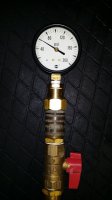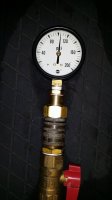I've had a water pressure gauge for probably over 20 years.....it's how I first figured out the pressure reducers weren't working in our other houses. However, it doesn't have a lazy hand on it, so I had to wait until the girlfriend went back home after the weekend (too much effort to get her to not touch the toilet or sinks for an hour and a half while the water heater went thru a full recovery cycle). First off, an amendment to my previous post.....turns out I do have a functioning PRV after all. I can likely trace that back to some work the water company did to our main line on our road about a year ago. After their work I noticed a slight pressure drop at all of our houses and at various frostproof hydrants spread around the farm.....just figured they had lowered the setting on their own PRV somewhere in their system. My house however had a steady rhythmic pulsing most noticeable at the faucets with aerators on them...not so noticeable in the shower or at the spigots. I figured it was air in the system from their work at the road.....there had indeed been a large initial surge of air and water when the water first came back on. I figured it would clear in short time, and it did, but it took a few weeks. I now wonder if that surging wasn't my PRV coming back to life after something akin to a de-fibrillating blast from the water main. Regardless, it now works. 60 psi is what it reads right after opening and closing a faucet. It tends to creep up to 65 psi if left to sit. Once it read 70, but I had run about a gallon of hot water thru the sink.....don't know if that cycled the water heater thermostat or not. Never saw it above 70psi though. Until I emptied all the hot water thru the bathtub, that is. Let it run until the temp dropped from 145 to 85 degrees. City water coming in right now is 55 degrees, so most of the hot had been exhausted. Calculated about 1.5 hours for full recovery (I have temporarily replaced my previously faulty lower element with
a good 4500 watt one, so things are working as they should with the water heater for now). After 30 minutes it was at 103 psi. At the one hour mark it was 105 psi. Same thing at 75 minutes. At an hour and a half the pressure had dropped to 90psi and the lower element had already shut off (verified with multimeter). Opened up a faucet for a few seconds on hot and cold and everything was back to 60psi and holding.
So...obviously a closed system, correct? Either at my PRV, or at the check valve at the meter 420 feet away. Is 105 psi during a recovery cycle generally considered too high? Incoming city pressure measured at the frostproof hydrant right after my city meter is 122 psi. Pressure at my brother's and my mom's is respectively 115 and 112, and that's INSIDE the houses...after the non-functioning PRVs. When I measured them 20 years ago when I first got the gauge, both their houses and the roadside hydrant at my meter were all reading over 130 psi. No damage has ever come of it.....one house was built in 1971...the other in 1982. Those two houses are copper pipe.....mine is CPVC (did I just admit I'm the blacksheep living in a house trailer at the other end of the farm...LOL). I know they say PVC will last a hundred years corrosion-wise, but is it inferior to copper and galvanized when it comes to handling high pressure? Or is the main concern of excess pressure one of fixtures and water heater tanks? Seats and springs are easy enough to replace...and we all seem to be getting about 15 years out of our water heaters. I wonder out of curiosity if the other two houses go up another 45 psi from 115 to 160 when the water heater is cycling. The non-working PRVs may not be preventing backflow to the street, but I'd say the recently installed meters do indeed. So they're both likely closed systems as well.
All this talk and I guess my two questions basically are:
1. Is 105 psi too ideally high for my CPVC pipes or my water heater?
2. Is the rhythmic surging I described earlier indicative of a PRV going bad (or in my case, going GOOD again)?
And while I'm at it, a third question. Considering the 45 psi spike I'm getting now with only a 40 gallon heater, there's no chance I'm going to be able to add a second 40 or maybe even a 50 gallon heater to the system and get away without adding an expansion tank as well, is there? As you mentioned light-heartedly at the end of your response ".......until it fails". We had a well on our other farm when I was a kid. I remember all too well having to climb down inside the well house every few months to pump up the waterlogged galvanized tank it had. I know bladder tanks are improvements over the old tanks, but it's still a weak link I'd rather not have in my system at all if it's not truly necessary.








